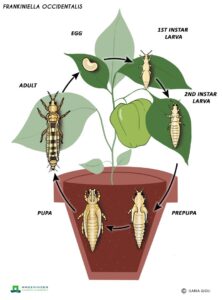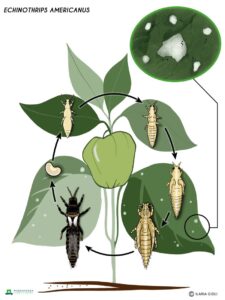Thrips are a growing problem in the cultivation of Anthuriums and Phalaenopsis. Whereas thrips were rare in Phalaenopsis a few years ago, they have become increasingly common in recent years. There is an increasing number of exotic thrips species, which require a specialist approach. The variety of chemical agents, on the other hand, is increasingly limited.
In addition, some thrips populations are resistant to chemical agents. The emphasis in recent years has therefore been on a preventive biological approach, plant resistance, and the targeted use of chemicals. The application technology is also attracting more and more attention. The growing problem of thrips in outdoor crops along with the limited range of pesticides is putting extra pressure on greenhouse crops.
In March 2019 a lot of attention was given to this issue, but thrips remains a problem: growers are still too often surprised by the increase in thrips and they also experience difficulties with their control.
Thrips pressure often varies by season. Outdoors and in unheated greenhouses, they will hibernate below 12°C. Thrips do not fly in at this time. This is why a good control in the autumn is important, as this will prevent thrips pupae being deposited in the substrate. Even in warm crops, depending on the climate, this will get rid of thrips for a few months.
In this article we discuss the different thrips that can be found in Phalaenopsis and Anthuriums. In collaboration with Koppert Biological Systems we will also explain the possibilities of biological control.
Recognition
Identifying thrips is specialist work that is done on the basis of their microscopic characteristics, such as the number of antennae, the colour of the wings, and their hair growth. It is important to know which thrips (or types of thrips) are found in greenhouses. Each type of thrips requires a different approach. This depends on the following factors:
- Time that thrips are active
- Sensitivity of thrips to certain pesticides
- Behaviour and spreading
- Placement of egg deposits or pupae
- Fly in at certain times of the year
- Life cycle
This information is particularly important when choosing the right agent if chemical or biological intervention is required. Most thrips pupate in the substrate. If thrips pupate on the leaf (Echinothrips), this may mean that the usage of nematodes or introducing soil predatory mites has less effect.
Life cycle
The life cycle of thrips consists typically of the following stages:
- Egg
- Larva (2 stages)
- Pupa (2-3 stages)
- Adult
The duration of the life cycle can be very variable. Firstly, temperature has a major influence on the duration of the life cycle of thrips. In general, thrips develop from egg to adult in three weeks at 20°C. At 30°C, however, it only takes 10 days. In addition, the crop on which they live has a major influence on the duration of their life cycle. One crop can be much more nutritious than another.
The location of thrips at certain times of the life cycle may vary. The different stages can be found in the soil, on the leaves, or on the young buds and flowers. The table shows where the different thrips pupate.
- Bron Ada Leman, research entomologist Wageningen UR Greenhouse Horticulture.
- Bron Ada Leman, research entomologist Wageningen UR Greenhouse Horticulture.
Figure 1, the life cycles of western flower thrips (left) and Echinothrips (right). Western flower thrips pupate in the substrate, while Echinothrips are found on the leaf throughout the life cycle.

Prof. Dr. Ir. G.J. Messelink of the Glasshouse Horticulture Business Unit at WUR has produced a thrips recognition chart, which can be used to identify the most common species. It is available at the following link.
Scouting
For optimum control and to prevent increasing damage, it is important that the thrips are detected quickly. Discovery begins with searching, or scouting. This takes time and is therefore costly. Unfortunately, scouting is an indispensable part of the approach. To prevent or limit damage to the crop, scouting is necessary at least once a week. Scouting also builds up knowledge. The first time may be difficult, but with experience thrips damage can be recognized faster and often it is easy to see which thrips are involved.
Scouting for thrips in orchids can be tricky. Not all thrips can be observed on sticky traps. This depends mainly on the level of activity. Species such as orchid thrips or Echinothrips are not very mobile and with these species good crop monitoring is important. The thrips are often found in the young parts of the plant and are light-sensitive. In Phalaenopsis, they are often found on the underside of the youngest leaf, on the stalk.
For species that are mobile, sticky traps can be used. Blue sticky traps are specific for thrips, which makes counting them easier. When five traps per 1,000 m2 are hung, a good picture can be formed of the number of thrips and their ‘hotspots’. Chemistry or biology can therefore be used in a targeted way.
Control
Thrips control in general is still often underestimated. The egg and pupal stage cannot be controlled chemically. Thrips in this phase will hatch anyway, and the population can continue to develop. It is therefore important that this kind of cycle is taken into account, and that one or two applications of insecticides will not be sufficient. Spraying only on Saturdays also has a minimal effect, as there are often fewer than seven days between thrips stages. The length of the stages depends on the time of year, the temperature, and the type of thrips. Furthermore, spraying one product after the other only has a moderate effect and creates a lot of resistance. With the use of blue sticky traps, scouting, and biological and chemical support, good thrips control can be achieved.
Spray pressure and maintenance
A common mistake is an excessively high spray pressure. Some growers spray with a pressure of 15 bar or more. This creates a very fine mist, which is pushed violently towards the crop. The drops are so fine and light, however, that they don’t get very far. At best, the spray liquid only reaches the outer parts of the crop and drips off easily. This is especially important when dealing with thrips that are hidden in the crop. At a lower pressure (around 6 bar), crop penetration is better. Also,even slight contamination of the nozzle can lead to poor dispersal. With water sensitive paper, the effect of a spraying session can easily be monitored. Crop penetration and droplet size can thus be easily made visible.
Many crop protection agents today are contact agents, especially in the case of biological agents, and the correct spraying technique is therefore of even greater importance.
Insect netting
Keeping insects out by means of good entrance control of incoming planting material is of great importance. Keeping insects out by using insect netting also helps. To keep thrips out, netting will never be 100% effective, but there have recently been developments in new netting techniques that to some extent address the disadvantages of current insect netting. Insect netting can be used not only in ventilation windows but also in the pad of the pad fan installation
Crop resistance to thrips
Crops that are resistant or less susceptible to insects can complement a sustainable approach with biological control well. Varieties that are less attractive to thrips or which contain substances that prevent thrips growth will slow down the population build-up. This makes it easier to achieve a biological equilibrium between the pest and a pesticide. This allows the biological approach to be minimized. Anthura is investigating the possibilities of finding insect resistance in our genetics and possibly cross-breeding it. Hopefully this will result in thrips resistant varieties in the future.
Thrips
There are several types of thrips that can be found in both Anthuriums and orchids. The most important are listed below..
- Chaetanaphothrips orchidii – Orchid / Anthurium thrips
| Life stage | Duration (at 20°C) |
| Egg | 7-8 days |
| Larva-adult | 20 days |
| Pupa | 20 days |
| Adult | Not known |
Duration can decrease significantly when the temperature is higher. At lower temperatures, the life cycle can last up to three months. At room temperature, the duration of the life cycle is about one month.
Adult: 0.8 – 1.3 mm long, 0.15 mm wide. Large red/purple eyes, eight antenna segments. The colour of the wings is light brown, with alternating darker and lighter stripes.
Eggs: Per female, maximum 100 eggs; average around 23 eggs. The eggs are banana-shaped and are laid in the tissue of the flower bud, leaf sheath or leaf.
Larvae: There are two stages. The first stage is white and the second stage yellow to orange. The larvae of the youngest stage often cluster together, while the second thrips stage migrates to the substrate to pupate.
Pupa: In the substrate. There are two stages, with the wings becoming longer and longer during development. The pupa can also be found in a kind of tiny cocoon on the leaf, but this is very sporadic.
Damage: in Anthurium, a large number can be found on and around the flowers. Thrips often enter the unopened buds.
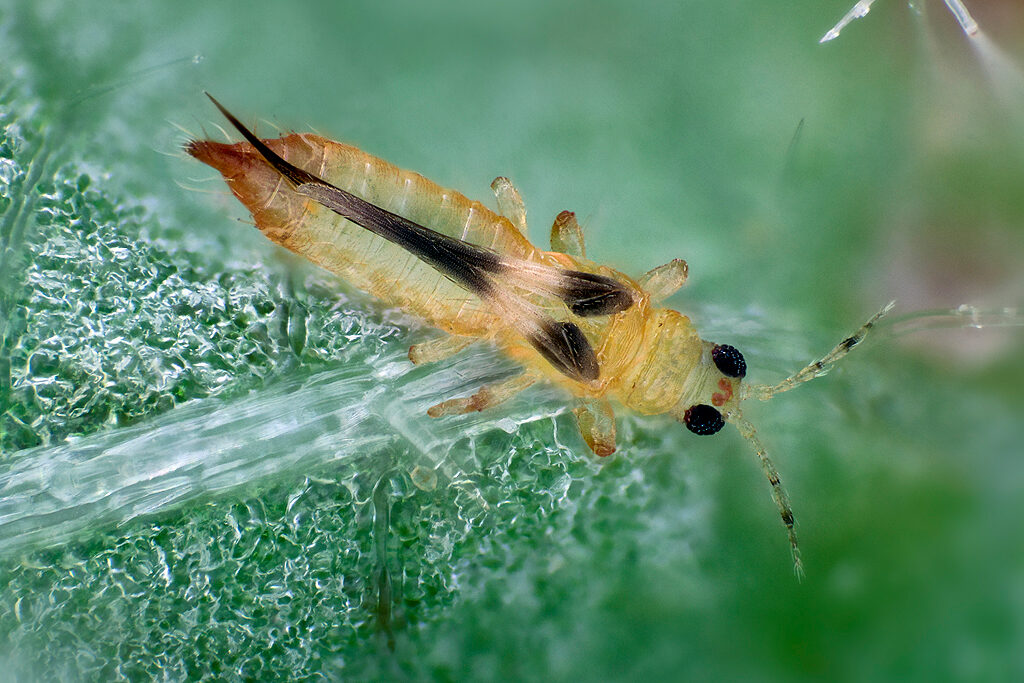
Dr. Manfred Ulitzka – Thrips-iD
- Frankliniella occidentalis – Western Flower thrips – Californian thrips
Recognition
The western flower thrips originated in America, but nowadays spread all over the world. The females are light yellow to dark brown in color and the adults are about 1.3-1.4 mm long. The males are smaller and paler in color than the females, reaching an adult length of 0.9-1.1mm. The larvae are light yellow in the first instar and as they get older they turn dark yellow / orange. The eggs are laid in the plant tissue and are kidney-shaped, white and 0.2 mm in size.
Damage symptoms
Western flower thrips are one of the most harmful types of thrips. These thrips can cause damage to the flowers, flower buds, leaves and vegetative points. Because of the relatively hard leaf of Phalaenopsis and Anthuriums, the growth points of the young leaves are more often affected. The nymph causes damage to the leaves, growth tops and flowering buds. On a leaf this leads to silver-grey spots with black dots: the excrement. In growing parts, deformities may occur due to the sucking action of the thrips. Adult thrips are attracted to pollen and can often be found around flowers. In Phalaenopsis they often feed on the petals, which causes spots on the flowers.
Life cycle
The western flower thrips has six stages. Unfertilized females produce male offspring. Fertilized eggs produce 30% female and 70% male offspring. Females produce about three eggs per day and under optimal conditions the population can double in four days. The development time is about 20 days at 20°C and 10 days at 30°C. The thrips pupate mainly in the soil or in damp, sheltered places. At temperatures above 35°C or below 10°C, development is halted.
Diseases
Western flower thrips can transmit tomato spotted wilt virus (TSWV) and Impatiens necrotic spot virus (INSV).
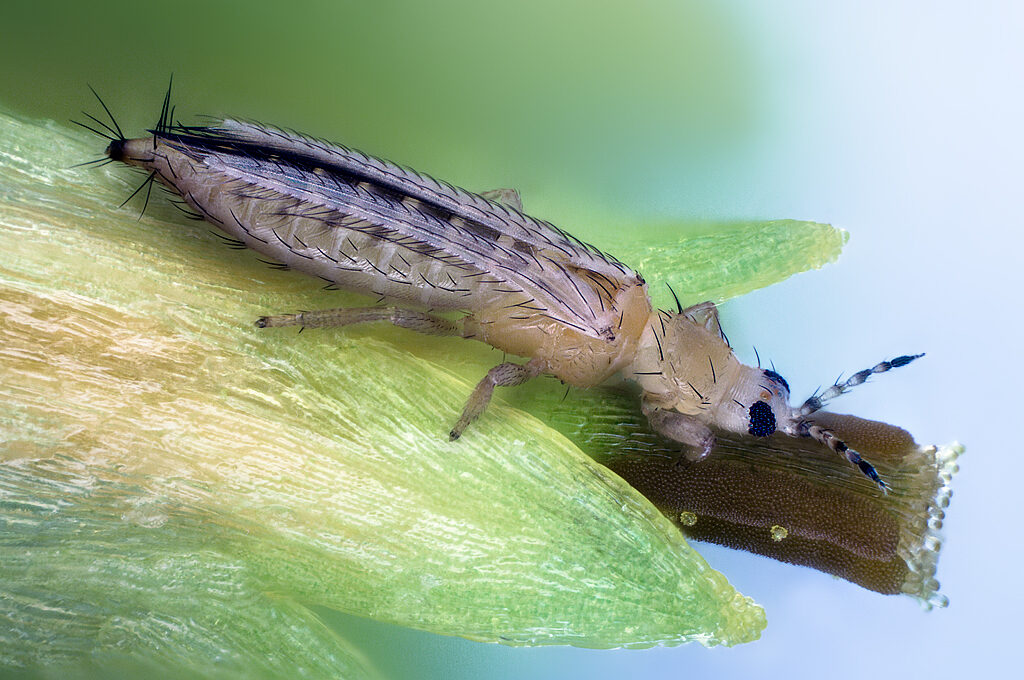
Dr. Manfred Ulitzka – Thrips-iD
- Echinothrips americanus
Recognition
In the Echinothrips americanus or poinsettia thrips, the body is dark, but there are white spots at the base of the wings. All stages can be found on the leaf, which distinguishes this thrips from Frankliniella occidentalis and Thrips tabaci. In Anthurium, this thrips initially gives problems at the bottom of the crop. As the population increases, higher crop areas are also affected. This seriously hinders the timely recognition of the problem.
Damage symptoms
These thrips are mainly found on the leaves and also cause abnormal damage there. The damage pattern consists of silvery dry spots and cork-like damage in the leaf, often starting at the leaf edges. At an earlier stage, many traces are found across the leaf.
Life cycle
The development of Echinothrips americanus takes 32 days at 20°C, 20 days at 25°C, and 11 days at 30°C
Diseases
Because of the size of the thrips they cannot be controlled biologically, but chemically there are some good options. Often these thrips are concentrated in certain places, because they are lazy flyers. It is still necessary to conduct checks in the farm, as the damage can be considerable.
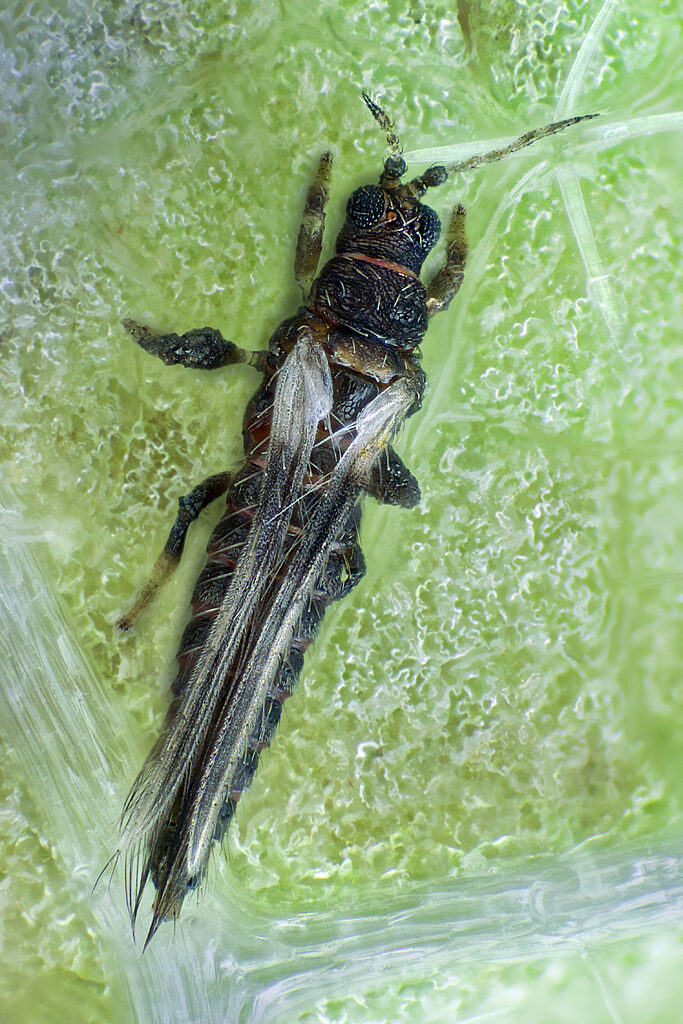
Dr. Manfred Ulitzka – Thrips-iD
- Thrips tabaci – Onion thrips
Recognition
Onion thrips can be found all over the world and were the main thrips pest in greenhouse farming in the 1980s. The eggs are laid in the leaf tissue and are light in colour. The larvae have bright red eyes. The second stage larvae are slightly larger and light yellow to green. The adult females are 0.8 – 1.2mm in size. Males are wingless and smaller and lighter than females. The colour of the adults depends on their diet.
Damage symptoms
Thrips tabaci can be found along the leaf veins and especially on the underside of the leaf. This thrips species does not usually settle on Anthurium and problems usually come from flying-in insects.
Life cycle
Development of T. tabaci takes 35 days at 15°C, 20 days at 20°C, 15 days at 25°C, and 10 days at 30°C.
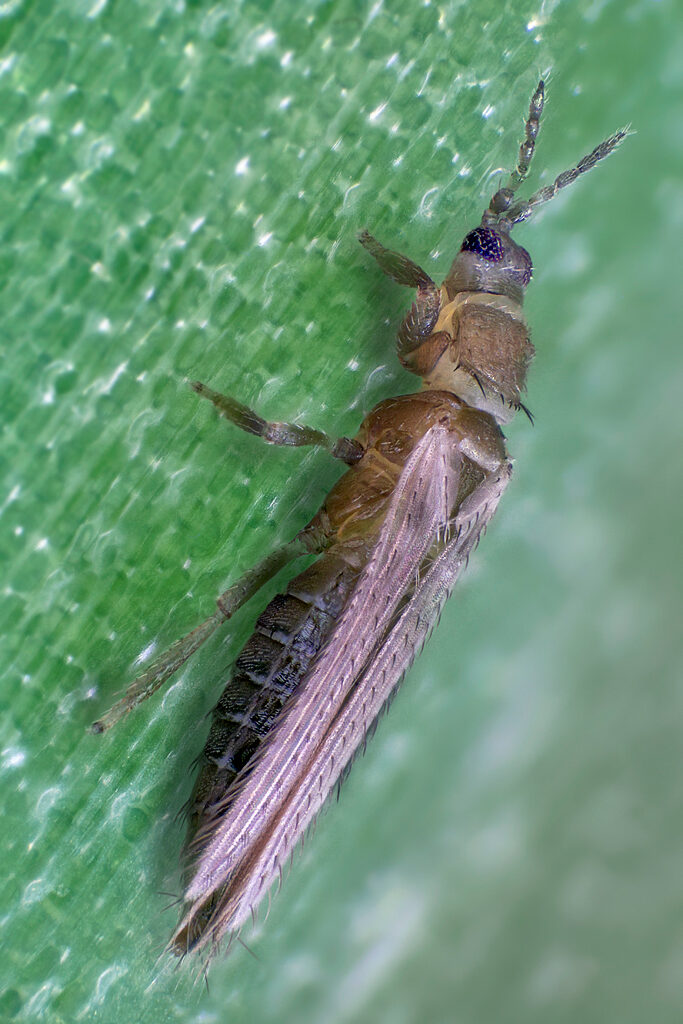
Dr. Manfred Ulitzka – Thrips-iD
- Dichromothrips corbetti
Recognition
Vanda thrips (Dichromothrips corbetti) can be recognized by its dark body. The base of the wings are light in colour. The thrips are 1 – 1.2 mm long and have eight antennal segments. The larvae are easily recognized by their yellow bodies and red eyes.
Damage symptoms
Corbetti is found on Cattleya, Cymbibdium, Dendrobium Phalaenopsis and vanda orchids. The flowers are particularly affected. The thrips have low mobility and are therefore rarely found on sticky traps. All stages of vanda thrips can be found in the plant.
Life cycle
The development of Dichromothrips corbetti takes 9-13 days.
Diseases
As far as we know, vanda thrips do not cause the spread of viruses.

Dr. Manfred Ulitzka – Thrips-iD

